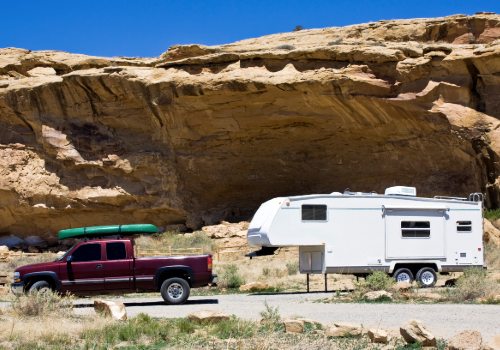Fifth-wheel trailers are very appealing to those that want a more residential feel and the best features in their towable camping experience. Those that are new to the category hesitate because their pickup truck’s bed can’t have the hitch in the way for work purposes. Removable 5th wheel hitches are a standard feature in the industry for that reason.
Our topic will focus on the best fifth wheel hitches in the 2020 market. We’ll show you different types of fifth wheel hitches and why they’re worth looking at. You’ll also learn about how the latest engineering techniques have adapted to all lengths of beds and cabs.
The Difference Between a Fifth Wheel And a Gooseneck Hitch
Before we get started, we wanted to spend a brief moment on clarifying the difference between a gooseneck and fifth wheel hitch. The term “gooseneck” is a slang term for a fifth-wheel RV, but this is an inaccurate description. Virtually all fifth-wheel travel trailers have hitches that semi-trucks use.
A gooseneck hitch is a ball mount that exists in the bed, or flatbed, of a truck. The trailer itself has a receiver that connects to the mount. Farm trailers, flatbed trailers, and other towables use this type of connection.
Fifth wheel RVs have a vertical cylinder at the end, called a kingpin. The kingpin fits into a horseshoe-shaped coupler hitch that sits in your truck’s bed. This connection sits above the rear axle to maximize towing strength (this is why tractor-trailers use it).
The Best Fifth Wheel Hitches For 2020
The criteria we used to determine our top picks for removable 5th wheel hitches come from a number of items. Our goal was to look at products that used the best materials and installed by most people. The hitch’s weight capacity had to be big enough to tow any fifth-wheel travel trailer the pickup truck could handle.
[insert spec table here]B&W Companion RVK 3500 Fifth Wheel Hitch: The Top-Rated 5th Wheel Hitch on the Market
- Weight Capacity: 20,000 pounds
- Hitch Weight: 131 pounds
- Frame Material: Steel
- Warranty: Limited lifetime
- Customer Review: 5 star
- Price Point: $957
B&W’s companion 5th wheel hitch has won Trailer Life Magazine Reader’s Choice Gold Award in 2015, 2016, 2017, and 2019. This fully articulating hitch is the updated version of the 3000 model. For easy removal, it separates into two separate parts, where the coupler itself is 75 pounds.
The engineers started out giving this hitch a wide stance for stability and strength. The polyurethane bushings absorb vibrations to give you a quiet and rattle-free towing experience. The one-inch thick jaws hold the kingpin tightly to prevent a loose start or stop.
When you’re ready to disconnect, the cam action latch won’t stick when you separate. If you want to keep things clean, you can purchase the graphite lube plate to avoid using lubricating grease. B&W also has a slide for the companion hitch to help with turning.
Andersen Hitches 3220 Gooseneck: Best 5th Wheel Hitch Alternative
- Weight Capacity: 20,000 pounds
- Hitch Weight: 35 pounds
- Frame Material: Aluminum
- Warranty: Lifetime
- Customer Review: 4.5 Star
- Price Point: $870
The Andersen hitch system is essentially a gooseneck extender that comes with everything you need to connect your fifth-wheel to it. One of the essential components is the Andersen Gooseneck Adapter block with a remote latch cable. When you look up Andersen’s Ultimate Hitch reviews, you’ll see this lightweight 5th wheel hitch is very popular due to its many features.
The hitch itself locks into your truck’s gooseneck ball mount. At the top of the hitch is another ball mount that the adapter block connects to. The other side of the rectangular block fits and locks your fifth wheel’s kingpin perfectly.
The remote cable and the block stay permanently attached to your trailer. The release handle operates the locking mechanism on the ball mount so you don’t have to climb into your truck’s bed to connect/disconnect to the hitch. See the above video to view its simple operation.
Lifting this hitch out of your truck is simple since it only weighs about 35 pounds. Installation/removal takes about 1-3 minutes. Traveling on a gooseneck hitch eliminates the chucking and bucking that comes with traditional fifth wheel hitches.
PullRite Superglide: Best 5th Wheel Hitch for ½ Ton Short Beds
- Weight Capacity: 12,000 pounds
- Hitch Weight: 316 pounds
- Frame Material: Steel
- Warranty: 5 year
- Customer Review: 4 Star
- Price Point: $1,714
Pulliam Enterprises designed the 3100 specifically for short bed trucks. The issue that many people face with short beds is turning problems. If you turn too tightly, the fifth wheel trailer hits the cab of the truck, damaging both.
This 5th wheel slider hitch allows the connection to move side-to-side. Drivers can make 90 degree turns without hitting their fifth wheel coach against their truck. When traveling, the hitch keeps your RV centered, minimizing sway and vibration.
How Truck Bed Liners Effect Your Fifth Wheel Hitch
If you have a plastic bed liner or carpet installed in your truck’s bed, removing those sections where your hitch connects is a good idea. When you tighten down your fifth wheel hitch’s base on top of them, they can prevent a truly secure connection to your truck or slowly loosen the bolts. Removing those sections so your hitch can make direct contact to the real bed surface is the best way to ensure an accurate hold.
Spray-in bed liners are another story. Essentially, the spray-in material is just a scratch-resistant coating of your existing bed. It won’t affect your hitch connection.
Don’t Remove Your 5th Wheel Hitch Rails
During the initial installation of your hitch, it may come with bed rails. Removing 5th wheel hitch rails is a bad idea. These rails are torqued into place and are one of the main connections for your trailer hitch. If you remove them and reattach them multiple times, they can lose their structural integrity.
There are two different designs hitch rails come in. They are either type specific to the manufacturer brand of your truck, or universal. Brand-specific parts have a better fit but are more expensive to replace. Rails sit flush, or near flush with your bed floor, so they shouldn’t get in the way when you’re not using your hitch.
What If I Have Questions About My 5th Wheel Hitch?

The operation, security, cleaning, and other issues about your hitch can raise questions that we haven’t covered. Every smart camper knows to keep their instruction manual handy in the folder the dealer provides with their RV. Most of the answers to your questions are in the manual, the manufacturer’s FAQ webpage, or their 800 phone number.
Common concerns that pop up are height adjustment. Since trucks and fifth wheel RVs are different, the hitch may need height correction so the RV rides a little higher or lower. The RV dealer who did the initial install of the hitch should walk you through this process well enough so you are comfortable with it.




